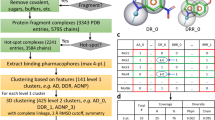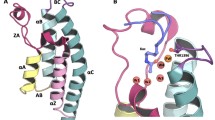Abstract
Here, we propose an in silico fragment-mapping method as a potential tool for fragment-based/structure-based drug discovery (FBDD/SBDD). For this method, we created a database named Canonical Subsite–Fragment DataBase (CSFDB) and developed a knowledge-based fragment-mapping program, Fsubsite. CSFDB consists of various pairs of subsite–fragments derived from X-ray crystal structures of known protein–ligand complexes. Using three-dimensional similarity-matching between subsites on one protein and another, Fsubsite compares the surface of a target protein with all subsites in CSFDB. When a local topography similar to the subsite is found on the surface, Fsubsite places a fragment combined with the subsite in CSFDB on the target protein. For validation purposes, we applied the method to the apo-structure of cyclin-dependent kinase 2 (CDK2) and identified four compounds containing three mapped fragments that existed in the list of known inhibitors of CDK2. Next, the utility of our fragment-mapping method for fragment-growing was examined on the complex structure of tRNA-guanine transglycosylase with a small ligand. Fsubsite mapped appropriate fragments on the same position as the binding ligand or in the vicinity of the ligand. Finally, a 3D-pharmacophore model was constructed from the fragments mapped on the apo-structure of heat shock protein 90-α (HSP90α). Then, 3D pharmacophore-based virtual screening was carried out using a commercially available compound database. The resultant hit compounds were very similar to a known ligand of HSP90α. As a result of these findings, this in silico fragment-mapping method seems to be a useful tool for computational FBDD and SBDD.
















Similar content being viewed by others
References
Oster L, Tapani S, Xue YF, Kack H (2015) Successful generation of structural information for fragment-based drug discovery. Drug Discov Today 20(9):1104
Wang T, Wu MB, Chen ZJ, Chen H, Lin JP, Yang LR (2015) Fragment-based drug discovery and molecular docking in drug design. Curr Pharm Biotechnol 16(1):11
Murray CW, Verdonk ML, Rees DC (2012) Experiences in fragment-based drug discovery. Trends Pharmacol Sci 33(5):224
Erlanson DA (2012) Introduction to fragment-based drug discovery. In: Davies GT, Hyvönen M (eds) Fragment-based drug discovery and x-ray crystallography. Springer, Berlin, p 1
Wyss DF, Wang YS, Eaton HL, Strickland C, Voigt JH, Zhu ZN, Stamford AW (2012) Combining NMR and X-ray crystallography in fragment-based drug discovery: discovery of highly potent and selective BACE-1 inhibitors. In: Davies TG, Hyvonen M (eds) Fragment-based drug discovery and X-ray crystallography, 317. Springer, Berlin, p 83
Rognan D (2012) Fragment-based approaches and computer-aided drug discovery. In: Davies TG, Hyvonen M (eds) Fragment-based drug discovery and X-ray crystallography, 317. Springer, Berlin, p 201
Goodford PJ (1985) A computational procedure for determining energetically favorable binding sites on biologically important macromolecules. J Med Chem 28(7):849
Miranker A, Karplus M (1991) Functionality maps of binding-sites—a multiple copy simultaneous search method. Proteins Struct Funct Genet 11(1):29
Kozakov D, Grove LE, Hall DR, Bohnuud T, Mottarella SE, Luo LQ, Xia B, Beglov D, Vajda S (2015) The FTMap family of web servers for determining and characterizing ligand-binding hot spots of proteins. Nat Protoc 10(5):733
Brenke R, Kozakov D, Chuang GY, Beglov D, Hall D, Landon MR, Mattos C, Vajda S (2009) Fragment-based identification of druggable ‘hot spots’ of proteins using Fourier domain correlation techniques. Bioinformatics 25(5):621
Sandor M, Kiss R, Keseru GM (2010) Virtual fragment docking by glide: a validation study on 190 protein-fragment complexes. J Chem Inf Model 50(6):1165
Kawatkar S, Wang HM, Czerminski R, Joseph-McCarthy D (2009) Virtual fragment screening: an exploration of various docking and scoring protocols for fragments using glide. J Comput Aided Mol Des 23(8):527
Nikolic D, Blinov N, Wishart D, Kovalenko A (2012) 3D-RISM-Docc: a new fragment-based drug design protocol. J Chem Theory Comput 8(9):3356
Imai T, Oda K, Kovalenko A, Hirata F, Kidera A (2009) Ligand mapping on protein surfaces by the 3D-RISM theory: toward computational fragment-based drug design. J Am Chem Soc 131(34):12430
Genheden S, Ryde U (2015) The MM/PBSA and MM/GBSA methods to estimate ligand-binding affinities. Expert Opin Drug Discov 10(5):449
Weis A, Katebzadeh K, Soderhjelm P, Nilsson I, Ryde U (2006) Ligand affinities predicted with the MM/PBSA method: dependence on the simulation method and the force field. J Med Chem 49(22):6596
Skolnick J, Gao M, Roy A, Srinivasan B, Zhou HY (2015) Implications of the small number of distinct ligand binding pockets in proteins for drug discovery, evolution and biochemical function. Bioorg Med Chem Lett 25(6):1163
Gao M, Skolnick J (2013) APoc: large-scale identification of similar protein pockets. Bioinformatics 29(5):597
Jalencas X, Mestres J (2013) Chemoisosterism in the proteome. J Chem Inf Model 53(2):279
Iwase K, Hirono S (1999) Estimation of active conformations of drugs by a new molecular superposing procedure. J Comput Aided Mol Des 13(5):499
Cheng TJ, Li X, Li Y, Liu ZH, Wang RX (2009) Comparative assessment of scoring functions on a diverse test set. J Chem Inf Model 49(4):1079
Wang RX, Fang XL, Lu YP, Yang CY, Wang SM (2005) The PDBbind database: methodologies and updates. J Med Chem 48(12):4111
Wang RX, Fang XL, Lu YP, Wang SM (2004) The PDBbind database: collection of binding affinities for protein–ligand complexes with known three-dimensional structures. J Med Chem 47(12):2977
Duan J, Dixon SL, Lowrie JF, Sherman W (2010) Analysis and comparison of 2D fingerprints: Insights into database screening performance using eight fingerprint methods. J Mol Graph Model 29(2):157
Sastry M, Lowrie JF, Dixon SL, Sherman W (2010) Large-scale systematic analysis of 2D fingerprint methods and parameters to improve virtual screening enrichments. J Chem Inf Model 50(5):771
Carhart RE, Smith DH, Venkataraghavan R (1985) Atom pairs as molecular features in structure–activity studies: definition and applications. J Chem Inf Comput Sci 25(2):64
Oda A, Yamaotsu N, Hirono S (2009) Evaluation of the searching abilities of HBOP and HBSITE for binding pocket detection. J Comput Chem 30(16):2728
Yamaotsu N, Oda A, Hirono S (2008) Determination of ligand-binding sites on proteins using long-range hydrophobic potential. Biol Pharm Bull 31(8):1552
Grädler U, Gerber H-D, Goodenough-Lashua DM, Garcia GA, Ficner R, Reuter K, Stubbs MT, Klebe G (2001) A new target for shigellosis: rational design and crystallographic studies of inhibitors of tRNA-guanine transglycosylase. J Mol Biol 306(3):455
Brenk R, Naerum L, Grädler U, Gerber H-D, Garcia GA, Reuter K, Stubbs MT, Klebe G (2003) Virtual Screening for submicromolar leads of tRNA-guanine transglycosylase based on a new unexpected binding mode detected by crystal structure analysis. J Med Chem 46(7):1133
Stengl B, Meyer EA, Heine A, Brenk R, Diederich F, Klebe G (2007) Crystal structures of tRNA-guanine transglycosylase (TGT) in complex with novel and potent inhibitors unravel pronounced induced-fit adaptations and suggest dimer formation upon substrate binding. J Mol Biol 370(3):492
Meyer EA, Furler M, Diederich F, Brenk R, Klebe G (2004) Synthesis and in vitro evaluation of 2-aminoquinazolin-4(3H)-one-based inhibitors for tRNA-guanine transglycosylase (TGT). Helv Chim Acta 87(6):1333
Law V, Knox C, Djoumbou Y, Jewison T, Guo AC, Liu Y, Maciejewski A, Arndt D, Wilson M, Neveu V, Tang A, Gabriel G, Ly C, Adamjee S, Dame ZT, Han B, Zhou Y, Wishart DS (2014) DrugBank 4.0: shedding new light on drug metabolism. Nucleic Acids Res 42(D1):D1091
Knox C, Law V, Jewison T, Liu P, Ly S, Frolkis A, Pon A, Banco K, Mak C, Neveu V, Djoumbou Y, Eisner R, Guo AC, Wishart DS (2011) DrugBank 3.0: a comprehensive resource for ‘Omics’ research on drugs. Nucleic Acids Res 39(suppl_1):D1035
Wishart DS, Knox C, Guo AC, Cheng D, Shrivastava S, Tzur D, Gautam B, Hassanali M (2008) DrugBank: a knowledgebase for drugs, drug actions and drug targets. Nucleic Acids Res 36(suppl_1):D901
Wishart DS, Knox C, Guo AC, Shrivastava S, Hassanali M, Stothard P, Chang Z, Woolsey J (2006) DrugBank: a comprehensive resource for in silico drug discovery and exploration. Nucleic Acids Res 34(suppl_1):D668
Halgren TA, Murphy RB, Friesner RA, Beard HS, Frye LL, Pollard WT, Banks JL (2004) Glide: a new approach for rapid, accurate docking and scoring. 2. Enrichment factors in database screening. J Med Chem 47(7):1750
Friesner RA, Banks JL, Murphy RB, Halgren TA, Klicic JJ, Mainz DT, Repasky MP, Knoll EH, Shelley M, Perry JK, Shaw DE, Francis P, Shenkin PS (2004) Glide: a new approach for rapid, accurate docking and scoring. 1. Method and assessment of docking accuracy. J Med Chem 47(7):1739
Congreve M, Carr R, Murray C, Jhoti H (2003) A rule of three for fragment-based lead discovery? Drug Discov Today 8(19):876
Reynolds CH, Tounge BA, Bembenek SD (2008) Ligand binding efficiency: trends, physical basis, and implications. J Med Chem 51(8):2432
Brenk R, Meyer E, Reuter K, Stubbs MT, Garcia GA, Diederich F, Klebe G (2004) Crystallographic study of inhibitors of tRNA-guanine transglycosylase suggests a new structure-based pharmacophore for virtual screening. J Mol Biol 338(1):55
Meyer EA, Brenk R, Castellano RK, Furler M, Klebe G, Diederich F (2002) De novo design, synthesis, and in vitro evaluation of inhibitors for prokaryotic tRNA-guanine transglycosylase: a dramatic sulfur effect on binding affinity. ChemBioChem 3(2–3):250
Desaphy J, Rognan D (2014) sc-PDB-Frag: a database of protein–ligand interaction patterns for bioisosteric replacements. J Chem Inf Model 54(7):1908
Wyatt PG, Woodhead AJ, Berdini V, Boulstridge JA, Carr MG, Cross DM, Davis DJ, Devine LA, Early TR, Feltell RE, Lewis EJ, McMenamin RL, Navarro EF, O’Brien MA, O’Reilly M, Reule M, Saxty G, Seavers LCA, Smith DM, Squires MS, Trewartha G, Walker MT, Woolford AJA (2008) Identification of N-(4-piperidinyl)-4-(2,6-dichlorobenzoylamino)-1H-pyrazole-3-carboxamide (AT7519), a novel cyclin dependent kinase inhibitor using fragment-based X-ray crystallography and structure based drug design. J Med Chem 51(16):4986
Angiolini M, Banfi P, Casale E, Casuscelli F, Fiorelli C, Saccardo MB, Silvagni M, Zuccotto F (2010) Structure-based optimization of potent PDK1 inhibitors. Bioorg Med Chem Lett 20(14):4095
Böhm H-J (1992) The computer program LUDI: a new method for the de novo design of enzyme inhibitors. J Comput Aided Mol Des 6(1):61
Hörtner SR, Ritschel T, Stengl B, Kramer C, Schweizer WB, Wagner B, Kansy M, Klebe G, Diederich F (2007) Potent inhibitors of tRNA-guanine transglycosylase, an enzyme linked to the pathogenicity of the shigella bacterium: charge-assisted hydrogen bonding. Angew Chem Int Ed 46(43):8266
Sharp SY, Roe SM, Kazlauskas E, Čikotienė I, Workman P, Matulis D (2012) Co-crystalization and in vitro biological characterization of 5-aryl-4-(5-substituted-2-4-dihydroxyphenyl)-1,2,3-thiadiazole Hsp90 inhibitors. PLoS ONE 7(9):e44642
Xu X-L, Sun H-P, Liu F, Jia J-M, Guo X-K, Pan Y, Huang H-Z, Zhang X-J, You Q-D (2014) Discovery and bioevaluation of novel pyrazolopyrimidine analogs as competitive Hsp90 inhibitors through shape-based similarity screening. Mol Inf 33(4):293
Acknowledgements
This work was supported in part by the Japan Society for the Promotion of Science (JSPS) KAKENHI Grant Number JP15K07899. We would like to thank Dr. Hiroyuki Yamasaki and Dr. Yoshihiko Nishibata (Pharmaceutical Informatics, School of Pharmacy, Kitasato University) for providing the FAS program.
Author information
Authors and Affiliations
Corresponding authors
Electronic supplementary material
Below is the link to the electronic supplementary material.
Rights and permissions
About this article
Cite this article
Yamaotsu, N., Hirono, S. In silico fragment-mapping method: a new tool for fragment-based/structure-based drug discovery. J Comput Aided Mol Des 32, 1229–1245 (2018). https://doi.org/10.1007/s10822-018-0160-8
Received:
Accepted:
Published:
Issue Date:
DOI: https://doi.org/10.1007/s10822-018-0160-8




